The best way to play Asia's coming financial services boom
As populations mature, they grow from being spenders to savers and back again. And so demand for shares rises and falls too. Cris Sholto Heaton has been looking into Asia's population trends, and sees a growing demand for finan- cial services in Asia. Here, he explains the best way to play it.

Financial news tends to be relentlessly short-term. What stocks went up yesterday? Whose results beat expectations and who missed? But if you're saving for the long term, this is just noise. The biggest impact on our investments comes from trends over years and decades.
And this week's theme is very long-term indeed. It's something we almost never think about because it changes so slowly. Yet it may be responsible for a lot of the market's ups and downs.
I'll say in advance that this is one of those subjects where it's hard to draw definite conclusions. But as best as I can tell, the outcome is pretty positive for Asia - and not at all encouraging for the developed world...
MoneyWeek
Subscribe to MoneyWeek today and get your first six magazine issues absolutely FREE

Sign up to Money Morning
Don't miss the latest investment and personal finances news, market analysis, plus money-saving tips with our free twice-daily newsletter
Don't miss the latest investment and personal finances news, market analysis, plus money-saving tips with our free twice-daily newsletter
The volatility of valuations
In the long run, returns on shares consist of two things: the dividends you receive, and the change in the price of shares. In turn, the price change breaks down into the change in earnings and the change in the valuation that investors are willing to put on the earnings (the price/earnings ratio).
I'm going to focus solely on the p/e ratio. As you know, this is very volatile. The chart below shows this rather well for the S&P 500. (As usual, I'm using US data here, because it's the best long-term series that we have.)
Price/earnings ratio for S&P 500
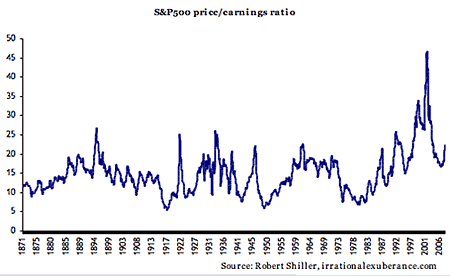
Even when you adjust for swings in earnings caused by booms and recessions, it's still pretty volatile. The chart below shows the cyclically adjusted p/e (CAPE), popularised by Robert Shiller. This divides the market price by the average of the last ten years' inflation-adjusted earnings. You can see a very clear pattern of the p/e expanding and contracting.
Cyclically adjusted price/earnings ratio for S&P 500 (via Capital Economics)
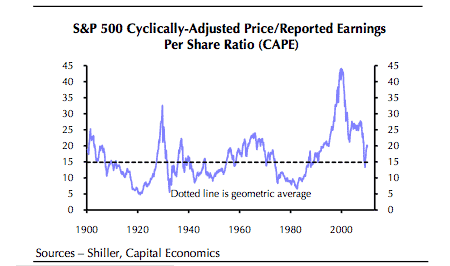
Why is this? One explanation is swings in investor optimism. At times such as the 1970s, with inflation high and labour unrest rising, investors are very uncertain about the future. So they put a low valuation on companies to reflect the fact that they don't know if conditions will improve.
At other times, they become irrationally optimistic and convinced that the boom they're enjoying will go on forever. This can turn into a mania. The dotcom era with technological breakthroughs, steadily falling inflation and benign global politics is a very good example.
Because investors' views only change slowly, it takes a long time for the CAPE to revert back to normal from extreme values. After the seventies, it took time for investors to become more optimistic. After the dotcom bust, investors were slow to recognise how excessive valuations had become and let them return to normal. Indeed, according the CAPE, they still haven't the S&P 500 is still apparently around 40% overvalued, and only briefly dipped back to being cheap during the worst of the global panic.
From spenders to savers to spenders again
That's one possible explanation. But another way to think about it is via demographics.
People's saving habits change depending on their age. Young people usually save little. Those in early middle age are much more likely to be paying into a pension. After retirement, most will be drawing down their savings to live on.
Shifts in the ratio of savers to non-savers should affect the demand for shares. And if the supply of shares doesn't grow in line, basic economics tell us what should happen. The price of shares will go up more than they otherwise would. In short, we should see p/es expand.
Does this happen in practice? Tim Bond of Barclays has a good essay on the topic in the latest issue of his firm's annual Equity Gilt Study. He produces quite a convincing argument that it does. The chart on the right below shows the relationship between the CAPE for the S&P 500 since 1950, and a modelled CAPE derived from US demographics. As you can see, there is a very good correlation between the two. (The one on the left shows the US long-term government bond. As you can see, demographics appear to explain this as well, but today I'll just focus on equities.)
S&P 500 CAPE versus modelled CAPE based on US demographics (via Barclays Capital)
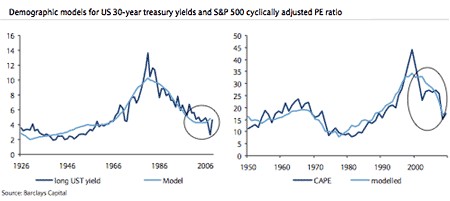
In fact, the correlation is so good it's almost odd. Would you really expect demographics to fully explain the change in the CAPE over time? Take the seventies, when p/es shrunk sharply. The normal explanation is that this is due to high inflation, volatile economies and investor uncertainty. Surely it makes more sense to have some variation driven by this, rather than simple demographics?
Well no. Bond argues that the two are effectively connected. It was the demographics of the seventies, with smaller labour force growth, that created this environment. Conversely the good times before and after reflected much better labour demographics.
That makes some sense. I'd be reluctant to conclude just from this one correlation covering a few decades that demographics explain all the movements in the CAPE. But it's almost certainly an important factor. Which leads us on to my main question: what do demographics say about the outlook for Asian markets?
Expert tips & advice for investing in Asia! Claim your FREE guides from MoneyWeek that include:
- How to go about investing to Asia
- Which brokers to use to buy foreign shares
Asia's growing pool of savers
I did some very simple number crunching on the same lines as Bond's study. I compared the ratio of people aged 40-49, to people aged 20-29 for a number of countries. I took data from 1991 (the earliest consistently available) up to 2050 (using projected population data). This ratio is known as the m/y ratio, for middle-aged/young. The results are grouped on the chart below.
Population ratios for Asia and selected other markets
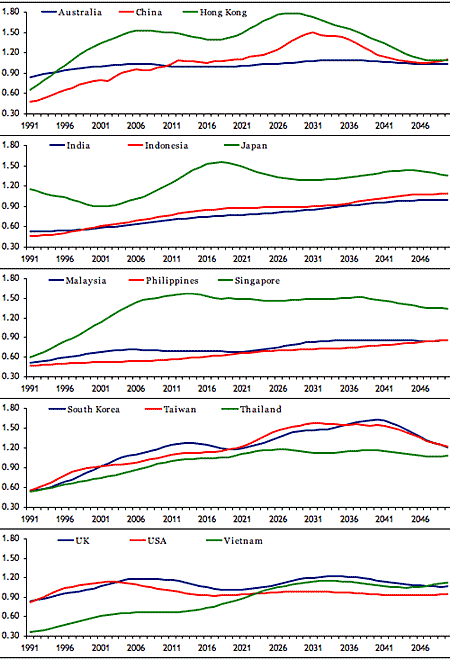
The results are apparently quite positive for most of Asia. Countries such as the UK and US face several years of declining m/y ratios. That may mean further declines in market valuations.
Some Asian markets also face headwinds. Hong Kong's ratio is set to fall over the next decade, while Malaysia and Singapore will be flat to slightly down. Korea and Japan are on course to peak and decline in the same period.
But China, India, Indonesia and Vietnam all have rising m/y ratios. That suggests their markets should be buoyed by demand from rising numbers of savers in years to come.
Obviously this conclusion comes with a long list of caveats. First, we're not considering whether the market is currently fairly valued or not. If a country is already on a much higher p/e than is justified, then it could still see valuations contract, despite favourable demographics. In my view, most of Asia is fairly valued, although the mainland Chinese market is probably on the expensive side. But without a long market history it's hard to be absolutely certain. Others may disagree.
Second, this looks solely at domestic factors. It doesn't take account of foreign investors, who can play a big part in many Asian markets. Numbers aren't always easy to get hold of or consistent, but the influence varies a lot. Mainland China is probably a few percent. India is probably about 10%-15%. Japan, South Korea, Taiwan and Singapore are probably all in the 20%-30% range.
So falling overseas investments from foreign countries with falling m/y ratios could perhaps offset growing investment from domestic savers. But I think the process is more likely to go the other way. Developed world savers are likely to allocate more funds to Asia in years to come.
Third, this essentially assumes that demand for shares from new savers outstrips supply. Is this valid? In emerging economies with underdeveloped capital markets, there might be a large number of firms that will float on the market as the economy develops, thereby increasing the supply.
Fourth, the saving population in an emerging market is very different to that in late-20th century America. The vast majority of Chinese and Indian citizens are not involved in the stock market or any form of investment. They save, if at all, in cash. Others who invest will do so in other forms such as property or precious metals.
This could be a negative. The demographics of the investing population may look nothing like the demographics of the overall country. After all, better-off people tend to have fewer children. Or it could be a positive. It may lead to a stream of future investors moving into the market as their wages rises, they join the middle class and their investing habits (and the local capital markets) become more sophisticated.
Fifth, the big problem with concluding anything based on America's experience, is that you're talking about the most successful economy of the 20th century. Experiences elsewhere can be very different and quite often worse for investors. In extreme cases, they've been wiped out by hyperinflation, civil war and revolutions. We can't rely on comparisons too much.
Asian valuations are already expanding
Still, there's reason to believe that demographics will help most Asian markets. In the past, I've argued that developed world markets especially the S&P 500 will see a valuation contraction in the next decade, while Asian ones see expansion.
If you compare the trend in the S&P 500 CAPE with the price/book (p/b) value for the MSCI Asia ex-Japan (AxJ), you can already see this process in action. The S&P 500 peaked in 2000 and is still shrinking, while the AxJ bottomed in the Asia crisis in 1997 and is still expanding. I'm using p/b for the AxJ because we don't have a long-term CAPE series for it p/b is the best available through-cycle measure.
Cyclically adjusted price/earnings ratio for S&P 500 (via Capital Economics)

Price/book ratio for the MSCI Asia ex Japan (via Citigroup)
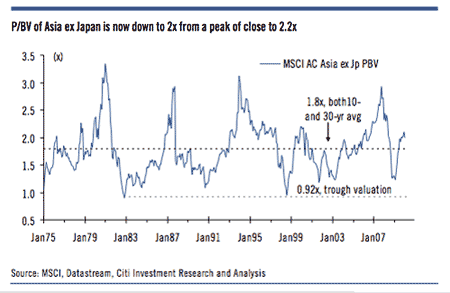
I viewed that as driven mostly by sentiment, as Asian economies outperform most of the developed world. And it's highly likely that foreign inflows and outflows will play a part, given that most of these markets are still small compared to the developed world investor pool. But it looks like local demographics will also be a helpful tailwind.
Good news for financial services
Apart from this being generally bullish for Asian markets, there's one obvious likely beneficiary the financial services industry. As the amount of savings put into the market grows, it will mean more business for brokers, fund management groups and other financial intermediaries.
It's notable that shares in investment managers such as Dreyfus, Franklin and Federated were very strong performers in the US during the eighties and nineties. It was over this period that the modern mutual fund industry expanded, as it successfully convinced people they were better putting their money in funds rather than investing directly in stocks.
Franklin Resources share price
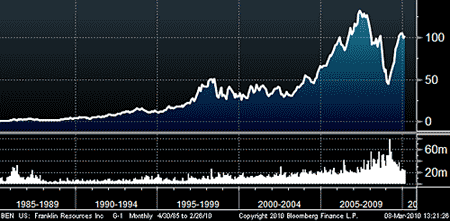
This could be a very promising long-term investment theme in Asia. My forthcoming second stock tip for the beta-test of my new Asia Investor email is loosely tied to this, as it provides support services for the financial industry. But I'm looking at more direct plays for future picks.
For those of you who prefer to invest through funds, there's only one dedicated Asian financials fund that I know of: the newly launched iShares MSCI Far East Financials Sector ETF (US: FEFN). But on a quick inspection, it doesn't seem suitable for a way to play this theme, being heavily weighted in Japanese megabanks and Hong Kong real estate.
I would regard a Singapore ETF as a more useful investment, given how important financial services and wealth management are likely to be to the future of its economy (see last week's article for more on this: Singapore - a cheap play on Asian growth). But clearly this isn't a pure play and it will be helpful when we have more focused sector ETFs for Asia.
This article is from MoneyWeek Asia, a FREE weekly email of investment ideas and news every Monday from MoneyWeek magazine, covering the world's fastest-developing and most exciting region. Sign up to MoneyWeek Asia here
Get the latest financial news, insights and expert analysis from our award-winning MoneyWeek team, to help you understand what really matters when it comes to your finances.
Cris Sholto Heaton is an investment analyst and writer who has been contributing to MoneyWeek since 2006 and was managing editor of the magazine between 2016 and 2018. He is especially interested in international investing, believing many investors still focus too much on their home markets and that it pays to take advantage of all the opportunities the world offers. He often writes about Asian equities, international income and global asset allocation.
Cris began his career in financial services consultancy at PwC and Lane Clark & Peacock, before an abrupt change of direction into oil, gas and energy at Petroleum Economist and Platts and subsequently into investment research and writing. In addition to his articles for MoneyWeek, he also works with a number of asset managers, consultancies and financial information providers.
He holds the Chartered Financial Analyst designation and the Investment Management Certificate, as well as degrees in finance and mathematics. He has also studied acting, film-making and photography, and strongly suspects that an awareness of what makes a compelling story is just as important for understanding markets as any amount of qualifications.
-
 8 of the best properties for sale with indoor gyms
8 of the best properties for sale with indoor gymsThe best properties for sale with indoor gyms – from a four-storey mews house in London’s Knightsbridge, to a 1920s Arts & Crafts house in Melbury Abbas, Dorset
-
 Top stock ideas for 2026 that offer solidity and growth
Top stock ideas for 2026 that offer solidity and growthLast year’s stock ideas from MoneyWeek’s columnist and trader, Michael Taylor, produced another strong performance. This year’s stocks look promising too
